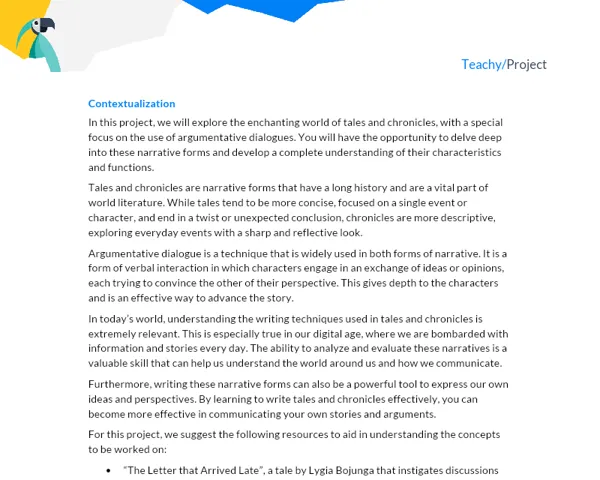Contextualization
Hello, little language explorers! We are about to embark on an incredible adventure, where we will enhance our writing skills and, at the same time, discover more about the world around us. Have you ever heard of logbooks? Did you know that they are written records of observations and experiences? And that, besides being useful to recall moments, they also help develop our writing skills? Yes, it's true!
Writing is a powerful tool we use every day to communicate and to express our thoughts and ideas. It can also be an amazing way to record our observations and learnings. When we write, we are organizing our ideas, choosing the words that best represent them, and sharing our experiences with others.
Introduction
In our project 'Developing Writing: Observation Records', we will learn to create our own logbook. In it, we will record our observations about something that interests us, such as an animal, a plant, a place, or even a special event. It will be like creating a treasure trove of words and drawings that will help us remember our adventures and discoveries.
Besides being a lot of fun, this project will help us improve our writing skills in various ways. First, we will practice writing complete and coherent sentences. Then, we will learn to choose the right words to describe our observations and feelings. We will also work on organizing our ideas, as the logbook is a sequential record of our experiences. Finally, we will explore the connection between writing and illustration, as we can use drawings to complement our texts.
Are you ready for this adventure? So, grab your pens and paper, let's start writing the first chapter of our logbooks!
Practical Activity: 'Creating the Logbook'
Project Objective
The objective of this project is for students to learn to observe different situations, describe them in written and visual form, and, above all, develop a pleasure for writing.
Project Description
In this project, students will collectively create a 'Logbook' about a visit to a garden, park, or even the classroom itself. They will observe details, take notes of their impressions and feelings, and draw.
Necessary Materials
- Notebooks or blank sheets of paper
- Colored pencils, markers, crayons
- Reference books about plants and animals (optional)
- Internet access (for research, if available)
Step by Step
-
Group Formation: Students will be divided into groups of 3 to 5 members. Each group will choose a name for their 'Explorer Team'.
-
Choosing the Location: Each group will choose a location to be the setting for their observations. It can be a garden, a park, or even the classroom.
-
Planning the Visit: The groups will plan a visit to the chosen location. They should think about which details they will observe and how they will record their observations (for example, taking photos, making drawings, writing words).
-
Visit and Observation: With the teacher's assistance, the groups will carry out the visit to the chosen location. They should observe attentively, collect information, and take notes of their impressions.
-
Recording in the Logbook: After the visit, each group will gather to record their observations in the 'Logbook'. They should describe the visited location, the plants and animals they saw, the sensations they had, among others. Students can also make drawings to illustrate their notes.
-
Presentation of the Logbook: Each group will present their 'Logbook' to the class. They will share their observations, show their drawings, and read their notes. The teacher can help students synthesize the information and organize the presentation.
-
Evaluation: After the presentations, the teacher will evaluate the students' participation, the content of the 'Logbook', and the presentation made.
Students should submit their 'Logbooks' at the end of the project. These logbooks will be a way to assess the student's progress in writing, observation, and description of their experiences. Remember, the idea is to have fun exploring and learning together!



